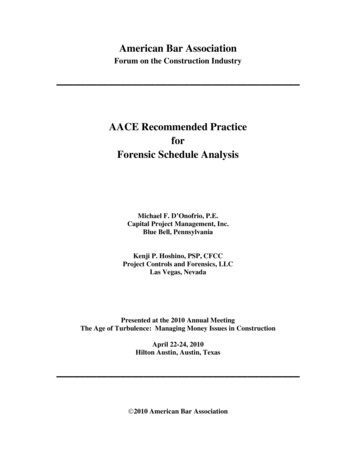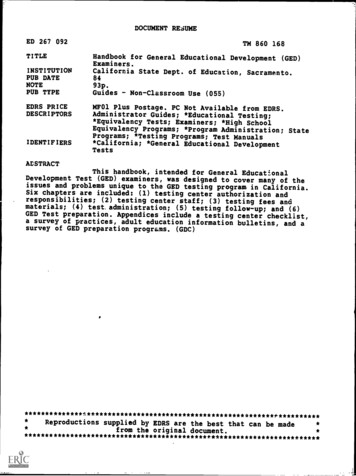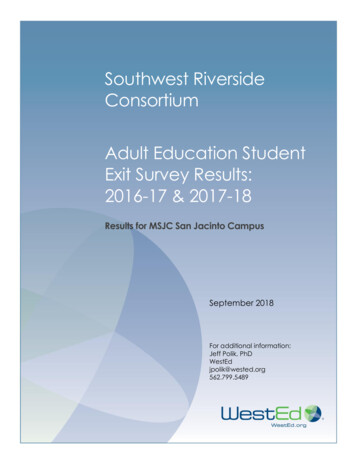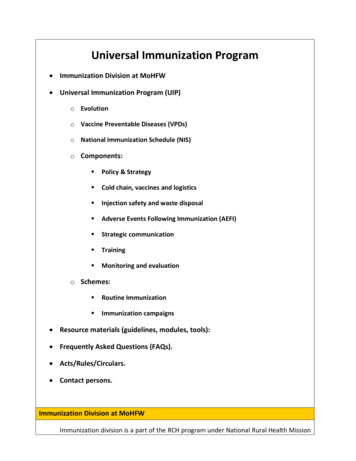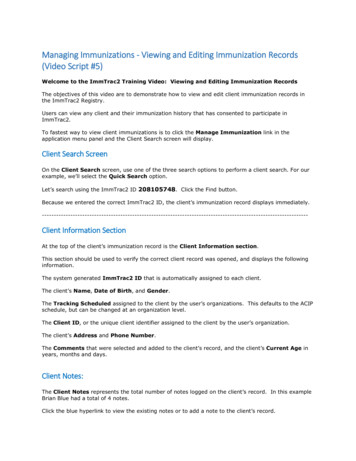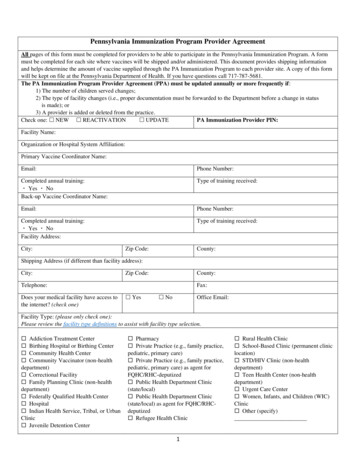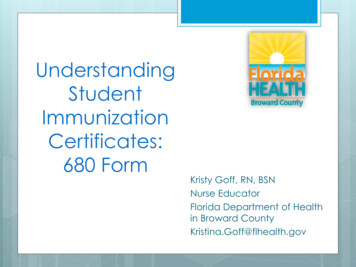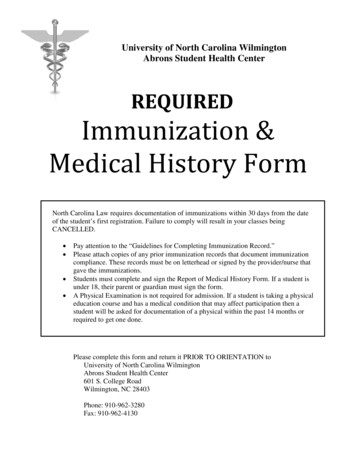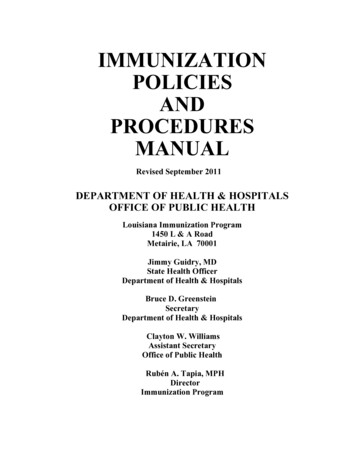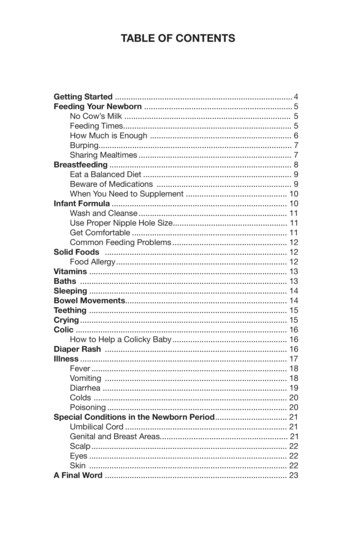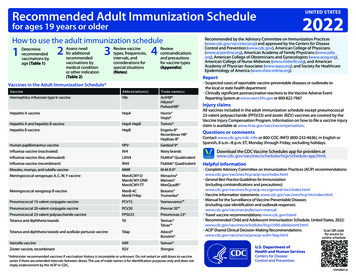
Transcription
Recommended Adult Immunization Schedulefor ages 19 years or olderHow to use the adult immunization schedule1 Determinerecommendedvaccinations byage (Table 1)2 ssess needAfor additionalrecommendedvaccinations bymedical conditionor other indication(Table 2)3 eview vaccineRtypes, frequencies,intervals, andconsiderations forspecial situations(Notes)4 eviewRcontraindicationsand precautionsfor vaccine types(Appendix)UNITED STATES2022Recommended by the Advisory Committee on Immunization Practices(www.cdc.gov/vaccines/acip) and approved by the Centers for DiseaseControl and Prevention (www.cdc.gov), American College of Physicians(www.acponline.org), American Academy of Family Physicians (www.aafp.org), American College of Obstetricians and Gynecologists (www.acog.org),American College of Nurse-Midwives (www.midwife.org), and AmericanAcademy of Physician Associates (www.aapa.org), and Society for HealthcareEpidemiology of America (www.shea-online.org).ReportVaccines in the Adult Immunization Schedule*VaccineAbbreviation(s)Trade name(s)Haemophilus influenzae type b vaccineHibActHIB Hiberix PedvaxHIB Hepatitis A vaccineHepAHavrix Vaqta Hepatitis A and hepatitis B vaccineHepA-HepBTwinrix Hepatitis B vaccineHepBEngerix-B Recombivax HB Heplisav-B y Suspected cases of reportable vaccine-preventable diseases or outbreaks tothe local or state health departmenty Clinically significant postvaccination reactions to the Vaccine Adverse EventReporting System at www.vaers.hhs.gov or 800‑822‑7967Injury claimsAll vaccines included in the adult immunization schedule except pneumococcal23-valent polysaccharide (PPSV23) and zoster (RZV) vaccines are covered by theVaccine Injury Compensation Program. Information on how to file a vaccine injuryclaim is available at www.hrsa.gov/vaccinecompensation.Questions or commentsContact www.cdc.gov/cdc-info or 800-CDC-INFO (800-232-4636), in English orSpanish, 8 a.m.–8 p.m. ET, Monday through Friday, excluding holidays.Human papillomavirus vaccineHPVGardasil 9 Influenza vaccine (inactivated)IIV4Many brandsInfluenza vaccine (live, attenuated)LAIV4FluMist QuadrivalentInfluenza vaccine (recombinant)RIV4Flublok QuadrivalentHelpful informationMeasles, mumps, and rubella vaccineMMRM-M-R II Meningococcal serogroups A, C, W, Y vaccineMenACWY-DMenACWY-CRMMenACWY-TTMenactra Menveo MenQuadfi Meningococcal serogroup B vaccineMenB-4CMenB-FHbpBexsero Trumenba Pneumococcal 15-valent conjugate vaccinePCV15Vaxneuvance Pneumococcal 20-valent conjugate vaccinePCV20Prevnar 20 Pneumococcal 23-valent polysaccharide vaccinePPSV23Pneumovax 23 Tetanus and diphtheria toxoidsTdTenivac Tdvax Tetanus and diphtheria toxoids and acellular pertussis vaccineTdapAdacel Boostrix y Complete Advisory Committee on Immunization Practices (ACIP) /index.htmly General Best Practice Guidelines for Immunization(including contraindications and neral-recs/index.htmly Vaccine information statements: www.cdc.gov/vaccines/hcp/vis/index.htmly Manual for the Surveillance of Vaccine-Preventable Diseases(including case identification and outbreak response):www.cdc.gov/vaccines/pubs/surv-manualy Travel vaccine recommendations: www.cdc.gov/travely Recommended Child and Adolescent Immunization Schedule, United States, escent.htmly ACIP Shared Clinical Decision-Making Recommendations:Scan QR codefor access icella vaccineVARVarivax Zoster vaccine, recombinantRZVShingrixDownload the CDC Vaccine Schedules app for providers html.online schedule* Administer recommended vaccines if vaccination history is incomplete or unknown. Do not restart or add doses to vaccineseries if there are extended intervals between doses. The use of trade names is for identification purposes only and does notimply endorsement by the ACIP or CDC.CS310021-A
Table 1Recommended Adult Immunization Schedule by Age Group, United States, 2022Vaccine19–26 years27–49 yearsInfluenza inactivated (IIV4) orInfluenza recombinant (RIV4)orInfluenza live, attenuated(LAIV4)or1 dose annually1 dose Tdap each pregnancy; 1 dose Td/Tdap for wound management (see notes)1 dose Tdap, then Td or Tdap booster every 10 yearsMeasles, mumps, rubella(MMR)Zoster recombinant(RZV)Human papillomavirus (HPV)1 or 2 doses depending on indication(if born in 1957 or later)2 doses(if born in 1980 or later)2 or 3 doses depending on age atinitial vaccination or condition27 through 45 years1 dose PCV15 followed by PPSV23OR1 dose PCV202 or 3 doses depending on vaccine2, 3,onorvaccine4 dosesordepending2, 3, or 4 doses dependingcondition on vaccine or conditionMeningococcal A, C, W, Y(MenACWY)1 or 2 doses depending on indication, see notes for booster recommendations2 or 3 doses depending on vaccine and indication, see notes for booster recommendations19 through 23 yearsHaemophilus influenzae type b(Hib) 2 doses1 dose PCV15 followed by PPSV23OR1 dose PCV20 (see notes)Hepatitis A(HepA)Meningococcal B(MenB)2 doses2 doses for immunocompromising conditions (see notes)Pneumococcal(PCV15, PCV20, PPSV23)Hepatitis B(HepB) 65 years1 dose annuallyTetanus, diphtheria, pertussis(Tdap or Td)Varicella(VAR)50–64 years ecommended vaccination for adults who meet age requirement,Rlack documentation of vaccination, or lack evidence of past infection1 or 3 doses depending on indication Recommended vaccination for adults with anadditional risk factor or another indication Recommended vaccination based on sharedclinical decision-making No recommendation/Not applicable
Table 2VaccineRecommended Adult Immunization Schedule by Medical Condition or Other Indication, United States, 2022PregnancyImmunocompromised(excluding HIVinfection)HIV infection CD4percentage and count 15% or 200 mm3 15% and 200 mm3End-stageAsplenia,Heart orrenalChronic livercomplementlung disease;disease, or ondiseasedeficienciesalcoholism1hemodialysisIIV4 or RIV4orContraindicated1 dose Tdap recaution1 or 2 doses depending on indication2 doses2 doses at age 19 years2 doses at age 50 years3 doses through age 26 years2 or 3 doses through age 26 years depending on age at initial vaccination or condition1 dose PCV15 followed by PPSV23 OR 1 dose PCV20 (see notes)2 or 3 doses depending on vaccineHepA3 doses(see notes)2, 3, or 4 doses depending on vaccine or condition1 or 2 doses depending on indication, see notes for booster recommendationsMenACWYPrecaution2 or 3 doses depending on vaccine and indication, see notes for booster recommendations3 doses HSCT3recipients onlyHib 1 dose annually1 dose Tdap, then Td or Tdap booster every 10 yearsPneumococcal(PCV15, PCV20,PPSV23)MenBMen whohave sexwith menorTdap or TdHepBHealth carepersonnel21 dose annuallyLAIV4HPVDiabetes Recommended vaccinationfor adults who meetage requirement, lackdocumentation ofvaccination, or lackevidence of past infection ecommended vaccinationRfor adults with an additionalrisk factor or anotherindication1 dose ecommended vaccinationRbased on shared clinicaldecision-making Precaution—vaccinationmight be indicated ifbenefit of protectionoutweighs risk of adversereaction ontraindicated or notCrecommended—vaccineshould not be administered.*Vaccinate after pregnancy.1. Precaution for LAIV4 does not apply to alcoholism. 2. See notes for influenza; hepatitis B; measles, mumps, and rubella; and varicella vaccinations. 3. Hematopoietic stem cell transplant. No recommendation/Not applicable
NotesRecommended Adult Immunization Schedule for ages 19 years or older, United States, 2022For vaccine recommendations for persons 18 yearsof age or younger, see the Recommended Childand Adolescent Immunization Schedule.COVID-19 VaccinationCOVID-19 vaccines are recommended within thescope of the Emergency Use Authorization orBiologics License Application for the particularvaccine. ACIP recommendations for the use ofCOVID-19 vaccines can be found at ovid-19.html.CDC’s interim clinical considerations for use ofCOVID-19 vaccines can be found at ons/covid-19vaccines-us.html.Haemophilus influenzae type b vaccinationSpecial situationsy Anatomical or functional asplenia (including sickle celldisease): 1 dose if previously did not receive Hib; if electivesplenectomy, 1 dose, preferably at least 14 days beforesplenectomyy Hematopoietic stem cell transplant (HSCT): 3-doseseries 4 weeks apart starting 6–12 months after successfultransplant, regardless of Hib vaccination historyHepatitis A vaccinationRoutine vaccinationy Not at risk but want protection from hepatitis A(identification of risk factor not required): 2-dose seriesHepA (Havrix 6–12 months apart or Vaqta 6–18 monthsapart [minimum interval: 6 months]) or 3-dose series HepAHepB (Twinrix at 0, 1, 6 months [minimum intervals: dose 1to dose 2: 4 weeks / dose 2 to dose 3: 5 months])Special situationsy At risk for hepatitis A virus infection: 2-dose series HepAor 3-dose series HepA-HepB as above- Chronic liver disease (e.g., persons with hepatitis B,hepatitis C, cirrhosis, fatty liver disease, alcoholic liverdisease, autoimmune hepatitis, alanine aminotransferase[ALT] or aspartate aminotransferase [AST] level greaterthan twice the upper limit of normal)- HIV infection- Men who have sex with men- Injection or noninjection drug use- Persons experiencing homelessness- Work with hepatitis A virus in research laboratory orwith nonhuman primates with hepatitis A virus infection- Travel in countries with high or intermediate endemichepatitis A (HepA-HepB [Twinrix] may be administeredon an accelerated schedule of 3 doses at 0, 7, and 21–30days, followed by a booster dose at 12 months)- Close, personal contact with international adoptee(e.g., household or regular babysitting) in first 60 daysafter arrival from country with high or intermediateendemic hepatitis A (administer dose 1 as soon asadoption is planned, at least 2 weeks before adoptee’sarrival)- Pregnancy if at risk for infection or severe outcome frominfection during pregnancy- Settings for exposure, including health care settingstargeting services to injection or noninjection drug usersor group homes and nonresidential day care facilities fordevelopmentally disabled persons (individual risk factorscreening not required)Hepatitis B vaccinationRoutine vaccinationy Age 19 through 59 years: complete a 2- or 3-, or 4-doseseries- 2-dose series only applies when 2 doses of Heplisav-B* areused at least 4 weeks apart- 3-dose series Engerix-B or Recombivax HB at 0, 1, 6 months[minimum intervals: dose 1 to dose 2: 4 weeks / dose 2 todose 3: 8 weeks / dose 1 to dose 3: 16 weeks])- 3-dose series HepA-HepB (Twinrix at 0, 1, 6 months[minimum intervals: dose 1 to dose 2: 4 weeks / dose 2 todose 3: 5 months])- 4-dose series HepA-HepB (Twinrix) accelerated scheduleof 3 doses at 0, 7, and 21–30 days, followed by a boosterdose at 12 months- 4-dose series Engerix-B at 0, 1, 2, and 6 months for personson adult hemodialysis (note: each dosage is double that ofnormal adult dose, i.e., 2 mL instead of 1 mL)*Note: Heplisav-B not recommended in pregnancy due tolack of safety data in pregnant womenSpecial situationsy Age 60 years or older* and at risk for hepatitis B virusinfection: 2-dose (Heplisav-B) or 3-dose (Engerix-B,Recombivax HB) series or 3-dose series HepA-HepB(Twinrix) as above- Chronic liver disease (e.g., persons with hepatitisC, cirrhosis, fatty liver disease, alcoholic liver disease,autoimmune hepatitis, alanine aminotransferase [ALT] oraspartate aminotransferase [AST] level greater than twiceupper limit of normal)- HIV infection- Sexual exposure risk (e.g., sex partners of hepatitis Bsurface antigen [HBsAg]-positive persons; sexually activepersons not in mutually monogamous relationships;persons seeking evaluation or treatment for a sexuallytransmitted infection; men who have sex with men)- Current or recent injection drug use- Percutaneous or mucosal risk for exposure to blood(e.g., household contacts of HBsAg-positive persons;residents and staff of facilities for developmentallydisabled persons; health care and public safety personnelwith reasonably anticipated risk for exposure to blood orblood-contaminated body fluids; hemodialysis, peritonealdialysis, home dialysis, and predialysis patients; patientswith diabetes)- Incarcerated persons- Travel in countries with high or intermediate endemichepatitis B*Note: Anyone age 60 years or older who does not meetrisk-based recommendations may still receive Hepatitis Bvaccination.Human papillomavirus vaccinationRoutine vaccinationy HPV vaccination recommended for all persons throughage 26 years: 2- or 3-dose series depending on age at initialvaccination or condition:- Age 15 years or older at initial vaccination: 3-dose seriesat 0, 1–2 months, 6 months (minimum intervals: dose 1 todose 2: 4 weeks / dose 2 to dose 3: 12 weeks / dose 1 todose 3: 5 months; repeat dose if administered too soon)- Age 9–14 years at initial vaccination and received 1dose or 2 doses less than 5 months apart: 1 additionaldose- Age 9–14 years at initial vaccination and received 2doses at least 5 months apart: HPV vaccination seriescomplete, no additional dose needed
NotesRecommended Adult Immunization Schedule, United States, 2022y Interrupted schedules: If vaccination schedule isinterrupted, the series does not need to be restartedy No additional dose recommended when any HPVvaccine series has been completed using therecommended dosing intervals.Shared clinical decision-makingy Some adults age 27–45 years: Based on shared clinicaldecision-making, 2- or 3-dose series as aboveSpecial situationsy Age ranges recommended above for routine and catchup vaccination or shared clinical decision-making alsoapply in special situations- Immunocompromising conditions, including HIVinfection: 3-dose series, even for those who initiatevaccination at age 9 through 14 years.- Pregnancy: Pregnancy testing is not needed beforevaccination; HPV vaccination is not recommended untilafter pregnancy; no intervention needed if inadvertentlyvaccinated while pregnantInfluenza vaccinationRoutine vaccinationy Age 19 years or older: 1 dose any influenza vaccineappropriate for age and health status annuallyy For the 2021–2022 season, see www.cdc.gov/mmwr/volumes/70/rr/rr7005a1.htmy For the 2022–23 season, see the 2022–23 ACIP influenzavaccine recommendations.Special situationsy Egg allergy, hives only: any influenza vaccine appropriatefor age and health status annuallyy Egg allergy–any symptom other than hives (e.g.,angioedema, respiratory distress) or required epinephrineor another emergency medical intervention: see Appendixlisting contraindications and precautionsy Severe allergic reaction (e.g., anaphylaxis) to a vaccinecomponent or a previous dose of any influenza vaccine:see Appendix listing contraindications and precautionsy History of Guillain-Barré syndrome within 6 weeks afterprevious dose of influenza vaccine: Generally, shouldnot be vaccinated unless vaccination benefits outweighrisks for those at higher risk for severe complications frominfluenzaMeasles, mumps, and rubella vaccinationMeningococcal vaccinationRoutine vaccinationSpecial situations for MenACWYy No evidence of immunity to measles, mumps, orrubella: 1 dose- Evidence of immunity: Born before 1957 (health carepersonnel, see below), documentation of receipt of MMRvaccine, laboratory evidence of immunity or disease(diagnosis of disease without laboratory confirmation isnot evidence of immunity)y Anatomical or functional asplenia (including sicklecell disease), HIV infection, persistent complementcomponent deficiency, complement inhibitor (e.g.,eculizumab, ravulizumab) use: 2-dose series MenACWY-D(Menactra, Menveo, or MenQuadfi) at least 8 weeks apartand revaccinate every 5 years if risk remainsy Travel in countries with hyperendemic or epidemicmeningococcal disease, or microbiologists routinelyexposed to Neisseria meningitidis: 1 dose MenACWY(Menactra, Menveo, or MenQuadfi) and revaccinate every 5years if risk remainsy First-year college students who live in residentialhousing (if not previously vaccinated at age 16 years orolder) or military recruits: 1 dose MenACWY (Menactra,Menveo, or MenQuadfi)y For MenACWY booster dose recommendations forgroups listed under “Special situations” and in an outbreaksetting (e.g., in community or organizational settingsand among men who have sex with men) and additionalmeningococcal vaccination information, see www.cdc.gov/mmwr/volumes/69/rr/rr6909a1.htmSpecial situationsy Pregnancy with no evidence of immunity to rubella:MMR contraindicated during pregnancy; after pregnancy(before discharge from health care facility), 1 dosey Nonpregnant women of childbearing age with noevidence of immunity to rubella: 1 dosey HIV infection with CD4 percentages 15% and CD4count 200 cells/mm3 for at least 6 months and noevidence of immunity to measles, mumps, or rubella:2-dose series at least 4 weeks apart; MMR contraindicatedfor HIV infection with CD4 percentage 15% or CD4 count 200 cells/mm3y Severe immunocompromising conditions: MMRcontraindicatedy Students in postsecondary educational institutions,international travelers, and household or close,personal contacts of immunocompromised personswith no evidence of immunity to measles, mumps, orrubella: 2-dose series at least 4 weeks apart if previouslydid not receive any doses of MMR or 1 dose if previouslyreceived 1 dose MMRy Health care personnel:- Born before 1957 with no evidence of immunity tomeasles, mumps, or rubella: Consider 2-dose series atleast 4 weeks apart for measles or mumps or 1 dose forrubella- Born in 1957 or later with no evidence of immunityto measles, mumps, or rubella: 2-dose series at least 4weeks apart for measles or mumps or at least 1 dose forrubellaShared clinical decision-making for MenBy Adolescents and young adults age 16–23 years (age16–18 years preferred) not at increased risk formeningococcal disease: Based on shared clinical decisionmaking, 2-dose series MenB-4C (Bexsero) at least 1 monthapart or 2-dose series MenB-FHbp (Trumenba) at 0, 6months (if dose 2 was administered less than 6 monthsafter dose 1, administer dose 3 at least 4 months after dose2); MenB-4C and MenB-FHbp are not interchangeable (usesame product for all doses in series)Special situations for MenBy Anatomical or functional asplenia (including sickle celldisease), persistent complement component deficiency,complement inhibitor (e.g., eculizumab, ravulizumab)use, or microbiologists routinely exposed to Neisseriameningitidis:y 2-dose primary series MenB-4C (Bexsero) at least 1 monthapart or 3-dose primary series MenB-FHbp (Trumenba) at 0,1–2, 6 months (if dose 2 was administered at least 6 monthsafter dose 1, dose 3 not needed); MenB-4C and MenB-FHbpare not interchangeable (use same product for all doses inseries); 1 dose MenB booster 1 year after primary series andrevaccinate every 2–3 years if risk remains
NotesRecommended Adult Immunization Schedule, United States, 2022y Pregnancy: Delay MenB until after pregnancy unless atincreased risk and vaccination benefits outweigh potentialrisksy For MenB booster dose recommendations for groupslisted under “Special situations” and in an outbreaksetting (e.g., in community or organizational settingsand among men who have sex with men) and additionalmeningococcal vaccination information, see www.cdc.gov/mmwr/volumes/69/rr/rr6909a1.htmNote: MenB vaccines may be administered simultaneouslywith MenACWY vaccines if indicated, but at a differentanatomic site, if feasible.Pneumococcal vaccinationRoutine vaccinationy Age 65 years or older who have not previously receiveda pneumococcal conjugate vaccine or whose previousvaccination history is unknown: 1 dose PCV15 or 1 dosePCV20. If PCV15 is used, this should be followed by adose of PPSV23 given at least 1 year after the PCV15dose. A minimum interval of 8 weeks between PCV15and PPSV23 can be considered for adults with animmunocompromising condition,* cochlear implant, orcerebrospinal fluid leak to minimize the risk of invasivepneumococcal disease caused by serotypes unique toPPSV23 in these vulnerable groups.y For guidance for patients who have already received aprevious dose of PCV13 and/or PPSV23, cial situationsy Age 19–64 years with certain underlying medicalconditions or other risk factors** who have not previouslyreceived a pneumococcal conjugate vaccine or whoseprevious vaccination history is unknown: 1 dose PCV15or 1 dose PCV20. If PCV15 is used, this should be followedby a dose of PPSV23 given at least 1 year after thePCV15 dose. A minimum interval of 8 weeks betweenPCV15 and PPSV23 can be considered for adults with animmunocompromising condition,* cochlear implant, orcerebrospinal fluid leak to minimize the risk of invasivepneumococcal disease caused by serotypes unique toPPSV23 in these vulnerable groups.y For guidance for patients who have already received aprevious dose of PCV13 and/or PPSV23, 7/2022*Note: Immunocompromising conditions include chronicrenal failure, nephrotic syndrome, immunodeficiency,iatrogenic immunosuppression, generalized malignancy,human immunodeficiency virus, Hodgkin disease, leukemia,lymphoma, multiple myeloma, solid organ transplants,congenital or acquired asplenia, sickle cell disease, or otherhemoglobinopathies.**Note: Underlying medical conditions or other riskfactors include alcoholism, chronic heart/liver/lungdisease, chronic renal failure, cigarette smoking, cochlearimplant, congenital or acquired asplenia, CSF leak, diabetesmellitus, generalized malignancy, HIV, Hodgkin disease,immunodeficiency, iatrogenic immunosuppression,leukemia, lymphoma, multiple myeloma, nephroticsyndrome, solid organ transplants, or sickle cell disease orother hemoglobinopathies.Tetanus, diphtheria, and pertussis vaccinationRoutine vaccinationy Previously did not receive Tdap at or after age 11 years:1 dose Tdap, then Td or Tdap every 10 yearsSpecial situationsy Previously did not receive primary vaccination seriesfor tetanus, diphtheria, or pertussis: 1 dose Tdapfollowed by 1 dose Td or Tdap at least 4 weeks after Tdapand another dose Td or Tdap 6–12 months after last Tdor Tdap (Tdap can be substituted for any Td dose, butpreferred as first dose), Td or Tdap every 10 years thereaftery Pregnancy: 1 dose Tdap during each pregnancy, preferablyin early part of gestational weeks 27–36y Wound management: Persons with 3 or more doses oftetanus-toxoid-containing vaccine: For clean and minorwounds, administer Tdap or Td if more than 10 years sincelast dose of tetanus-toxoid-containing vaccine; for all otherwounds, administer Tdap or Td if more than 5 years sincelast dose of tetanus-toxoid-containing vaccine. Tdap ispreferred for persons who have not previously receivedTdap or whose Tdap history is unknown. If a tetanus-toxoidcontaining vaccine is indicated for a pregnant woman, useTdap. For detailed information, see la vaccination- Evidence of immunity: U.S.-born before 1980 (except forpregnant women and health care personnel [see below]),documentation of 2 doses varicella-containing vaccineat least 4 weeks apart, diagnosis or verification of historyof varicella or herpes zoster by a health care provider,laboratory evidence of immunity or diseaseSpecial situationsy Pregnancy with no evidence of immunity to varicella:VAR contraindicated during pregnancy; after pregnancy(before discharge from health care facility), 1 dose ifpreviously received 1 dose varicella-containing vaccineor dose 1 of 2-dose series (dose 2: 4–8 weeks later) ifpreviously did not receive any varicella-containing vaccine,regardless of whether U.S.-born before 1980y Health care personnel with no evidence of immunityto varicella: 1 dose if previously received 1 dose varicellacontaining vaccine; 2-dose series 4–8 weeks apart ifpreviously did not receive any varicella-containing vaccine,regardless of whether U.S.-born before 1980y HIV infection with CD4 percentages 15% and CD4count 200 cells/mm3 with no evidence of immunity:Vaccination may be considered (2 doses 3 months apart);VAR contraindicated for HIV infection with CD4 percentage 15% or CD4 count 200 cells/mm3y Severe immunocompromising conditions: VARcontraindicatedZoster vaccinationRoutine vaccinationy Age 50 years or older: 2-dose series RZV (Shingrix) 2–6months apart (minimum interval: 4 weeks; repeat doseif administered too soon), regardless of previous herpeszoster or history of zoster vaccine live (ZVL, Zostavax)vaccination (administer RZV at least 2 months after ZVL)Special situationsy Pregnancy: There is currently no ACIP recommendationfor RZV use in pregnancy. Consider delaying RZV until afterpregnancy.y Immunocompromising conditions (including HIV): RZVrecommended for use in persons age 19 years or olderwho are or will be immunodeficient or immunosuppressedbecause of disease or therapy. For detailed information, tine vaccinationy No evidence of immunity to varicella: 2-dose series 4–8weeks apart if previously did not receive varicella-containingvaccine (VAR or MMRV [measles-mumps-rubella-varicellavaccine] for children); if previously received 1 dose varicellacontaining vaccine, 1 dose at least 4 weeks after first doseCenters for Disease Control and Prevention Recommended Adult Immunization Schedule, United States, 2022
AppendixRecommended Adult Immunization Schedule, United States, 2022Guide to Contraindications and Precautions to Commonly Used VaccinesAdapted from Table 4-1 in Advisory Committee on Immunization Practices (ACIP) General Best Practice Guidelines for Immunization: Contraindication and Precautions available at ntraindications.html and ACIP’s Recommendations for the Prevention and Control of 2021-22 Seasonal Influenza with Vaccines available im clinical considerations for use of COVID-19 vaccines including contraindications and precautions can be found tions1Precautions2Influenza, egg-based,inactivated injectable (IIV4) Severe allergic reaction (e.g., anaphylaxis) after previous dose of any influenza vaccine(i.e., any egg-based IIV, ccIIV, RIV, or LAIV of any valency) Severe allergic reaction (e.g., anaphylaxis) to any vaccine component3 (excluding egg) Guillain-Barré syndrome (GBS) within 6 weeks after a previous dose of any type ofinfluenza vaccine Persons with egg allergy with symptoms other than hives (e.g., angioedema,respiratory distress) or required epinephrine or another emergency medicalintervention: Any influenza vaccine appropriate for age and health status may beadministered. If using egg-based IIV4, administer in medical setting under supervisionof health care provider who can recognize and manage severe allergic reactions. Mayconsult an allergist. Moderate or severe acute illness with or without feverInfluenza, cell culture-basedinactivated injectable[(ccIIV4), Flucelvax Quadrivalent] Severe allergic reaction (e.g., anaphylaxis) to any ccIIV of any valency, or to anycomponent3 of ccIIV4 Guillain-Barré syndrome (GBS) within 6 weeks after a previous dose of any type ofinfluenza vaccine Persons with a history of severe allergic reaction (e.g., anaphylaxis) after a previousdose of any egg-based IIV, RIV, or LAIV of any valency. If using ccIV4, administer inmedical setting under supervision of health care provider who can recognize andmanage severe allergic reactions. May consult an allergist. Moderate or severe acute illness with or without feverInfluenza, recombinantinjectable [(RIV4), Flublok Quadrivalent] Severe allergic reaction (e.g., anaphylaxis) to any RIV of any valency, or to anycomponent3 of RIV4 Guillain-Barré syndrome (GBS) within 6 weeks after a previous dose of any type ofinfluenza vaccine Persons with a history of severe allergic reaction (e.g., anaphylaxis) after a previousdose of any egg-based IIV, ccIIV, or LAIV of any valency. If using RIV4, administer inmedical setting under supervision of health care provider who can recognize andmanage severe allergic reactions. May consult an allergist. Moderate or severe acute illness with or without feverInfluenza, live attenuated[LAIV4, Flumist Quadrivalent] Severe allergic reaction (e.g., anaphylaxis) after previous dose of any influenza vaccine(i.e., any egg-based IIV, ccIIV, RIV, or LAIV of any valency) Severe allergic reaction (e.g., anaphylaxis) to any vaccine component3 (excluding egg) Adults age 50 years or older Anatomic or functional asplenia Immunocompromised due to any cause including, but not limited to, medications andHIV infection Close contacts or caregivers of severely immunosuppressed persons who require aprotected environment Pregnancy Cochlear implant Active communication between the cerebrospinal fluid (CSF) and the oropharynx,nasopharynx, nose, ear, or any other cranial CSF leak Received influenza antiviral medications oseltamivir or zanamivir within the previous 48hours, peramivir within the previous 5 days, or baloxavir within the previous 17 days. Guillain-Barré syndrome (GBS) within 6 weeks after a previous dose of any type ofinfluenza vaccine Asthma in persons aged 5 years old or older Persons with egg allergy with symptoms other than hives (e.g., angioedema,respiratory distress) or required epinephrine or another emergency medicalintervention: Any influenza vaccine appropriate for age and health status may bead
Vaccine 19-26 years 27-49 years 50-64 years 65 years Influenza inactivated (IIV4) or Influenza recombinant (RIV4) 1 dose annually Influenza live, attenuated
